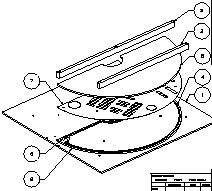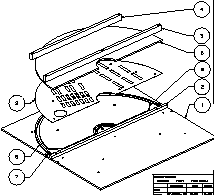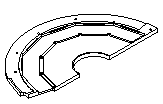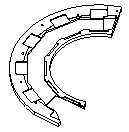The mechanical drawings are here
- Inner D-ring to endplate sheet (r.h.s. of the jig):
- Put the assembly jig up on some 2x blocks.
- File a notch in the inner D ring. Check the orientation by placing the D-ring on the jig. The O-ring notch should be down for both MVD3 and MVD4-type endplates. Place the sheet on the jig. The pattern drawn on the jig in black makes an MVD3-type endplate, and green makes an MVD-4 type. The notch should be filed on the side of the power connectors. Drawing here.
- Clean the glue surfaces with alcohol to remove grease.
- Place the D-ring on the jig. Check orientation.
- Prepare the glue: Epotek silver epoxy, kept in the chemical safe in the tent. Mix 10:1 by weight. For the 2 D-rings, 4g should enough.
- Glue the pieces together. This side has a pair of alignment pins. Place the top pressure plate and bars, and add a few small clamps in the 3 o'clock region.
- Put the whole assembly into the oven, up on 2x blocks to keep it clear from the bottom and sides. Cure 2h at 85C.
- Trim protruding sheet with file or scalpel.
- Outer D-ring to endplate sheet (l.h.s. of the jig):
- Clean the glue surfaces with alcohol to remove grease. Check the orientation of the sheet. The pattern drawn on the jig in black makes an MVD3-type endplate, green for MVD-4.
- File a smaller notch corresponding to the one in the inner D-ring. This one only has to be 1mm deep. Check the orientation: The O-ring notch should be up for both the MVD3 and MVD4-type endplates.
- Place the D-ring on the jig. The O-ring notch should be up (down) to make an MVD3 (MVD4)-type endplate.
- Screw the 5 little tabs to the perimeter of the D-ring, and put fresh teflon tape along the center bar. These will hold the sheet in place, and prevent gluing to the center bar.
- Prepare the glue, same as before. Mix 10:1 by weight, 4g should enough.
- Glue the pieces together: Place the top pressure plate and bars, and add a few small clamps in the 9 o'clock region.
- Put the whole assembly into the oven, up on 2x blocks to keep it clear from the bottom and sides. Cure 2h at 85C.
- Trim protruding sheet with file or scalpel.


|

